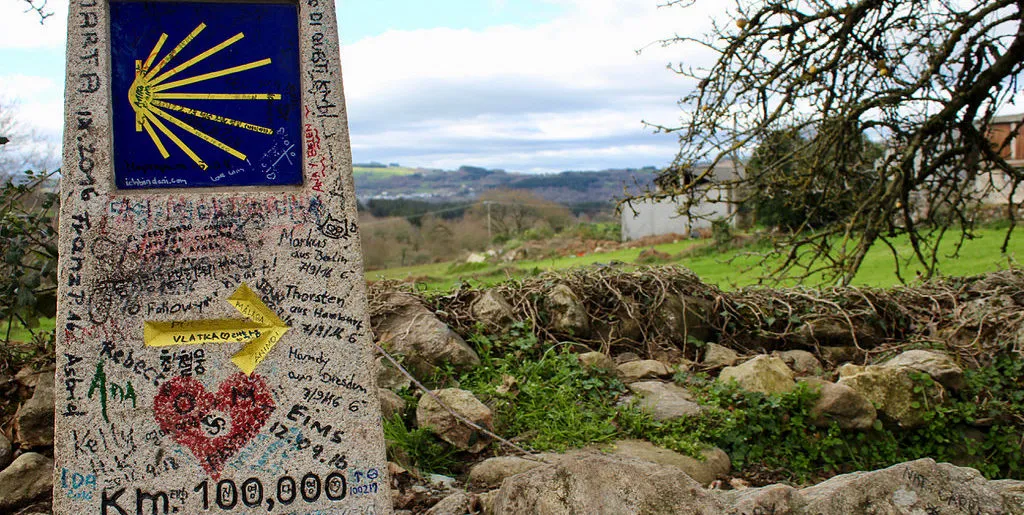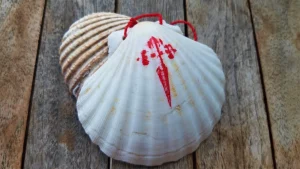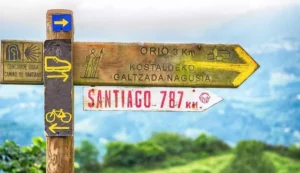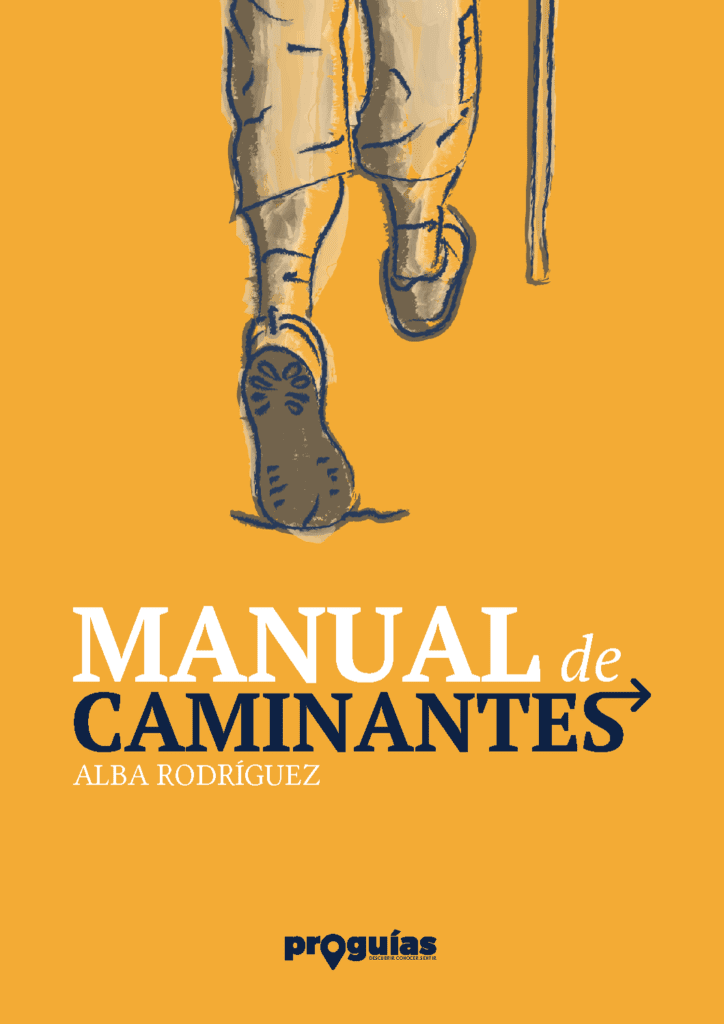If you're just starting out on the Camino de Santiago for the first time you will have already read or even heard of the famous "last 100 km of the Camino de Santiago". If you do not have many days to dedicate to the Camino, they are a fantastic option. And the same if what you are looking for is a first contact with the pilgrimage. So now we will explain a little more about this concept of "100 km" and what it implies.
Why do the last 100 km of the Camino de Santiago?
First, let's answer one of the questions we have been asked the most: why 100 km? Some say that this is a reference fabricated by the Galician government to ensure that most people do the Camino in Galicia. But, if you think about it, it does not make much sense. After all, the Camino ends in Santiago, so, one way or another, the pilgrim or pilgrim will end up arriving in Galicia.
The origin of this reference to the last 100 kilometres is to be found, in reality, in the religious authorities. It was the chapter of the S.A.M.I Cathedral of Santiago who established that, in order to obtain the Compostela (the religious document that certifies your pilgrimage to the tomb of the apostle), you have to do, at least, the last 100 kilometres on foot and walk to the cathedral (if you come by bike, you will have to do at least the last 200 km). The key words in both cases are "at least". You can do more kilometres if you want. The important thing to know is that only the last 100 kilometres will be taken into account to obtain the Compostela. In addition, you have to do them along one of the routes (with their variants) that the cathedral officially recognises: French, Primitive, Portuguese, Northern, English or Via de la Plata.
Some time ago we wrote a comprehensive article about which of the Caminos was the most appropriate for each type of pilgrim, depending on their interests. Here we explain which Camino to choose taking into account the specific interest of those last 100 km, how many days you would need for each route and everything you need to know to make the best decision.
One last general detail: although we usually talk about "the last 100 km of the Camino de Santiago", the reference starting points for these distances are usually a little further away. This is the case of Sarria, 114 km from Santiago. If you really wanted to do the last hundred on the French Way you should start at Morgade, a tiny village of only 3 inhabitants that has a small accommodation unable to lodge all the people who want to do this last stretch. That's why we will almost always have to adapt to the terrain, and the last 100 km end up being the last 110 or 120 km.
The French Way from Sarria (114 km)

It is the busiest route and usually the most common for those pilgrims who begin, for the first time, their adventure on the Camino de Santiago. This is no coincidence, because, in fact, it is also the one that receives more promotion. However, it has advantages that are there regardless of the publicity that is done.
For example, it is an easy route to walk, with almost no physical difficulties. The last 100 km are not very steep (although Galicia is not exactly flat). It can be done in 5 stages, that is to say: 7 days, taking into account that the day of arrival in Sarria we do not walk and then we have another day in Santiago to get to know it in depth. It is the perfect option for those who want to invest a week in the Camino and enjoy this experience.
This section between Sarria and Santiago has a good number of intermediate towns, so you will have plenty of options to stop and rest. What's more, it is also perfect for those who prefer to do shorter stages than usual, as many of these intermediate towns offer services and accommodation. Just keep in mind that if you want to do 10-15 km per day instead of the traditional 20-30 km, you will obviously need to invest twice as much time.
The longest stage of this section, between Palas de Rei and Arzúa, is almost 30 km long. So there are also many people who, doing the traditional stages, divide this one in two, spending the night in Melide. One of the great advantages of the Camino de Santiago is that it is very flexible and can almost always be adapted to our needs or abilities.
If you choose to do the last 100 km of the French Camino de Santiago, we recommend the spring and autumn months, avoiding, if possible, the summer months. Why? Because, being precisely the best known route, during the summer months many people take advantage of their holidays to embark on the Camino. This means that this route becomes overcrowded and it is difficult to find accommodation if you have not booked well in advance. If you are looking for a more solitary experience, the Camino has other more suitable routes. But, if you don't mind the extra crowds, this Camino is perfect for you.
Finally, you should think about how to get to Sarria. At this article We keep you up to date on the different ways to do this.
The Portuguese Way from Tui (114 km) or from Baiona (124 km)

Although the second most popular Camino is the Portuguese Way through the interior, its coastal variant has more and more followers every day. And it is not by chance. If you want to do the last 100 km of the Portuguese Way of Saint James, you should start in Tui (inland variant) or in Baiona (coastal variant). But keep in mind the following: if you start in Baiona you will only have two truly coastal stages (Baiona - Vigo and Vigo - Cesantes), since both routes converge shortly before reaching the city of Pontevedra and from there they always go inland. Therefore, if your intention is to walk along the Atlantic coast for several days, it is best not to limit yourself to the last 100 km and start, for example, in the Portuguese city of Porto or, failing that, in the Galician border town of A Guarda.
Like the last 100 km of the French Camino de Santiago, those of the Portuguese Way are perfectly conditioned for pilgrims, whether you leave from Tui or from Baiona. It is a simple route, without great physical demands, with many small towns along the entire Camino that will allow you to rest when you want. And the Portuguese Way runs through the most populated area of Galicia: the Rías Baixas.
In the case of the inland route, it can also be done in 5 stages, although the longest of them (32 km between Tui and Redondela) is usually divided in O Porriño. Thus, there are 6 days of walking, plus the day of arrival in Tui and the free day after spending the night in Santiago.
At the same time, the distribution of towns along the route allows us, as on the French Way, to define short stages if we need to. In this way, we can take better advantage of the day to make visits nearby or to enjoy the different localities of a route that has more monumental heritage than the French. Not in vain, it will pass through cities such as Pontevedra (where you should stop to explore its historic area), and medieval towns such as Tui or Baiona.
Finally, as with the French route, we recommend that you do the Portuguese Way in spring or autumn, thus avoiding the greatest influx of people. Although if you do the coastal variant in summer you can enjoy the beaches at the end of your stage.
The English Way from Ferrol (113 km)

The so-called English Way was born as a pilgrimage route for the journeys of English, Scottish, Irish, Scandinavian, Flemish and other countries' devotees who arrived by boat to the Galician ports of A Coruña and Ferrol. From there, they continued south on foot to reach Santiago. The recovery of this route has defined, at present, two possible starting points: Ferrol or A Coruña. However, only one - Ferrol - meets the requirement of "the last 100 kilometres of the Camino de Santiago".
It is, in any case, a pleasant and well signposted itinerary, which is gaining more and more walkers every year but still does not offer great availability of accommodation, so we recommend that you always make reservations in advance.
The mild and pleasant temperatures in this part of Galicia make it an ideal route to walk at any time of the year. And, in addition, it has a good combination of nature and historical heritage. Ferrol has a good number of points of interest and, as you progress, you will be able to visit medieval towns such as Pontedeume and Betanzos.
With a standard division of stages, you will not need more than 5 days of walking, to which you should add the day of arrival in Ferrol and the day after the last night in Santiago. In total, a week's duration which makes this route an easy experience to fit into holidays or festive periods. In addition, as it brings together fewer pilgrims than the French or Portuguese routes, it is also perfect to do even in the middle months of summer.
The Sanabrés Way from Ourense (106 km)

Another option to do "the last 100 km of the Camino de Santiago" reaching the city of the apostle is the so-called Camino Sanabrés or Camino del Sureste, which is actually a variant of the better known Vía de la Plata. This Silver Route runs from south to north, connecting in Astorga with the French Way, so, strictly speaking, it does not reach Santiago. However, at the height of Granja de Moreruela, a variant starts from it which goes directly to Galicia without joining the French route. It enters through the region of Sanabria (hence its name) and crosses the province of Ourense and part of the province of Pontevedra.
The Camino Sanabrés is a delight for those seeking a more introspective experience of their pilgrimage, as it is by far the one with the fewest people on it. To do its last 100 km, you can start in Ourense, covering the distance in 5 stages (plus the 2 additional days, again). Ourense is one of the provincial capitals of Galicia and has a remarkable historical and artistic heritage. In its cathedral you will be able to see, among other wonders, the Portico del Paraíso, sister of the Pórtico de la Gloria in Santiago de Compostela. The rest of the stages are essentially rural, passing through some medium-sized towns such as Lalín. In addition, if you are one of those people who enjoy gastronomy, this section of the Sanabrés Way is famous for the bread of Cea and the Galician stew of Lalín.
Our recommendation is to avoid the central weeks of summer, because although temperatures in Galicia are usually mild, the truth is that the province of Ourense usually has the most extreme ones. If the heat is not a problem for you, free way all year round!
Handbook of Pilgrims
Download the most complete guide to prepare the Camino de Santiago from scratch and step by step.
Finally, we are going to refer to two other routes of the Camino de Santiago whose last kilometres run largely along the French Way, but which come from other places. Let us begin with the Primitive Way.
The Primitive Way from Lugo (104 km)

The Primitive Way begins in Oviedo and runs in an east-west direction, linking the ancient capital of the Asturian-Galician kingdom with Santiago de Compostela. Its origin dates back to the pilgrimage of King Alfonso II, who visited the apostolic tomb when he was informed of its discovery by the bishop of Iria Flavia, Teodomiro. It is said of Alfonso II that this led him to become the first pilgrim, which is probably false (because his pilgrimage took place in 834, and the tomb had been discovered at least four years earlier). What is certain is that he was the first of whom we have documentary evidence and can identify. The last 100 km of the primitive Way of Saint James.
People who do the Camino Primitivo do not usually limit themselves to the last 100 kilometres, because the temptation to walk the landscapes of western Asturias and overcome the Ancares - the mountain barrier that links Asturias and Galicia - is too great. However, if you have limited time, the place to start and fulfil the distance requirement is undoubtedly Lugo, 104 km from Santiago.
Lugo is one of the oldest cities in Galicia, and is noted for its Roman heritage - starting with its spectacular 2 km long city wall. The start of the Camino here is, in fact, at the Santiago gate in the wall. However, as we say, this Camino meets the French route at Melide, so, by limiting ourselves to the last 100 kilometres, three of the five stages needed to walk that distance will actually run along the French route. This means a considerable increase in the number of people you will find walking alongside you, and also that you will need to prepare in advance to secure accommodation.
North Road from Baamonde (108 km)

The second route that joins the French route is the Camino del Norte. This is a route whose main attraction is walking along the spectacular Spanish Cantabrian coast. However, if we limit ourselves to the last 100 km of the route, it is true that the coast will be left far behind. This is not to say that the section is unattractive. The monastery of Sobrado dos Monxes is one of the must-sees of this Camino, wherever you start. And the scenery of inland Galicia is as beautiful on this route as on any other.
On the other hand, as is the case with the Primitive Way, the last two stages of this route will actually run along the French Way, since the Primitive Way joins it in Arzúa. Therefore, if you only have a week, the reference to meet at least the requirement of "the last 100 km of the Camino de Santiago" in this route is to start in the small town of Baamonde, which is 108 km from Santiago (provided that, when leaving that town, we opt for the road that goes through Miraz, and not by the variant of As Cruces).
This variant reduces the Camino by 8 km and, if you are fit, allows you to reach Sobrado dos Monxes in a single day. But it is physically demanding and has no intermediate locations, making it even harder.






